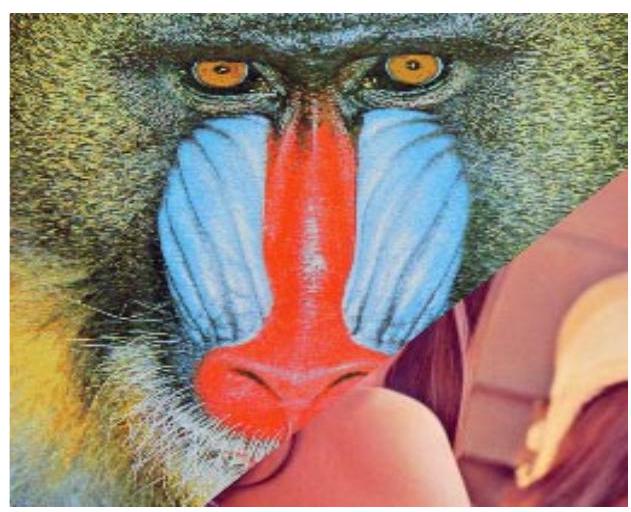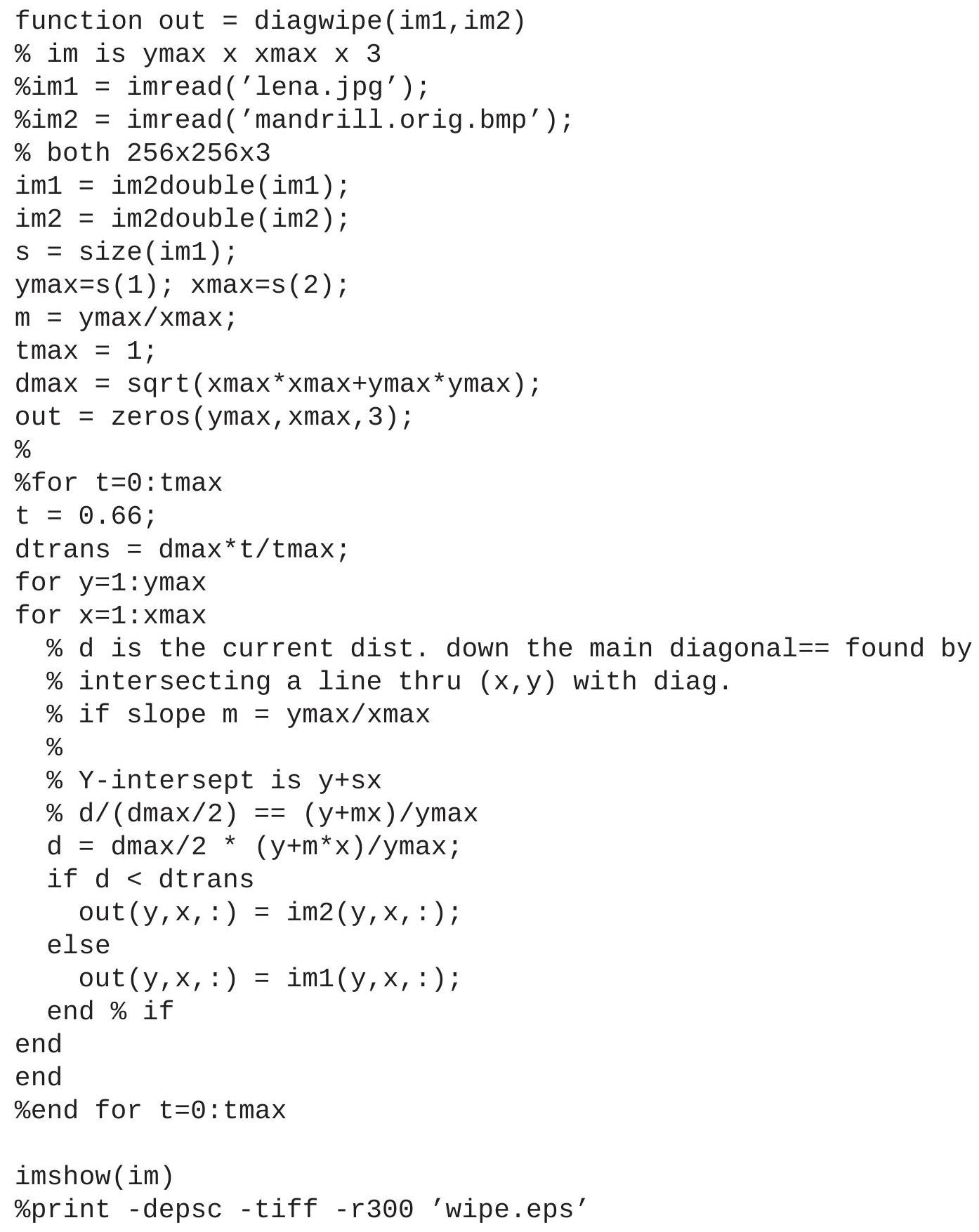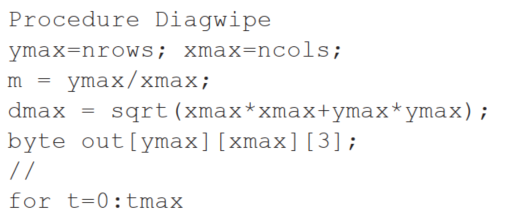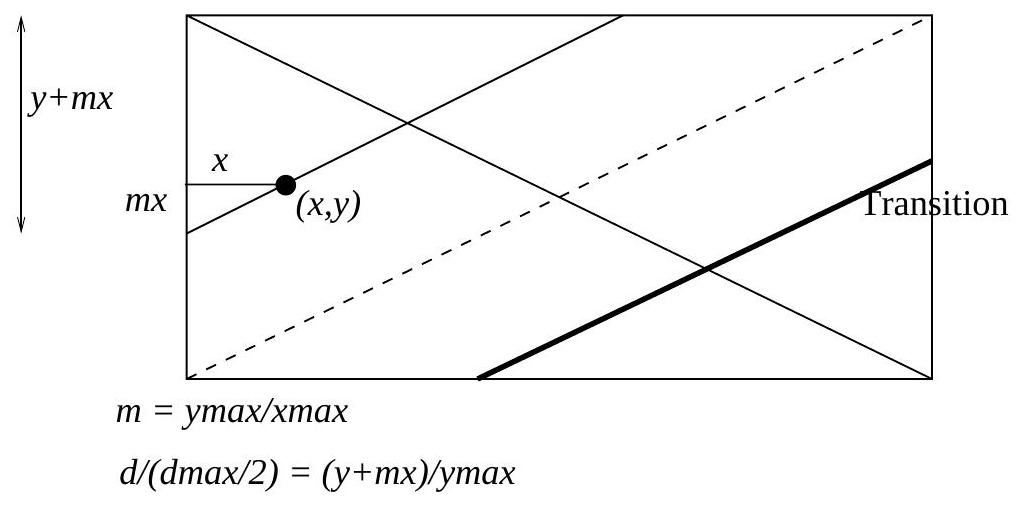Deck 1: Multimedia Authoring, Tools, Graphics and Image Data Representations
Question
Question
Question
Question
Question
Question
Question
Question
Question
Question

Unlock Deck
Sign up to unlock the cards in this deck!
Unlock Deck
Unlock Deck
1/10
Play
Full screen (f)
Deck 1: Multimedia Authoring, Tools, Graphics and Image Data Representations
1
Dissolve: Suppose we have video1 dissolving into video2, over a time from 0 to (video1 gradually disappears, and video2 gradually appears).
There are 2 ways that this task is commonly carried out: "Ordinary Dissolve" and "Dither Dissolve". In Ordinary Dissolve, every pixel value is changed, over time, so that it contains partly the contents of video1 and partly the contents of video2, summed additively. In Dither Dissolve, pixels are either all-video1 or all-video2, not a mix; the decision of which video to take pixel values from is based on a random number generator.
Write pseudocode solutions for accomplishing these two kinds of gradual video transition. For each type, just show the algorithm for filling up R (Red) values - Green and Blue will be similar.
There are 2 ways that this task is commonly carried out: "Ordinary Dissolve" and "Dither Dissolve". In Ordinary Dissolve, every pixel value is changed, over time, so that it contains partly the contents of video1 and partly the contents of video2, summed additively. In Dither Dissolve, pixels are either all-video1 or all-video2, not a mix; the decision of which video to take pixel values from is based on a random number generator.
Write pseudocode solutions for accomplishing these two kinds of gradual video transition. For each type, just show the algorithm for filling up R (Red) values - Green and Blue will be similar.

2
A simple (image independent) way of converting a full-color (24-bit color) RGB image into an 8-bit color (GIF) image is to allocate, e.g., 3 bits each to and , and 2 bits to . This results in poor quality of color, since you'll always only have 8 levels for R, G, and 4 levels for B, respectively.
Describe in sufficient detail an image dependent color conversion algorithm that will take into account of color content of the image so as to yield better 8-bit color (GIF) images.
Describe in sufficient detail an image dependent color conversion algorithm that will take into account of color content of the image so as to yield better 8-bit color (GIF) images.
Median-cut is the simplest approach. A better way would be to carry out a Karhunen-Loève analysis - could simply use a Singular Value Decomposition to optimally decorrelate the color channels.
(Very good students could be directed towards thinking about Independent Component Analysis.)
(Very good students could be directed towards thinking about Independent Component Analysis.)
3
How would you create your own video wipe transition from the top-left corner of the viewport down to the bottom-right corner - a diagonal transition? Fig. 2.1 shows such a video transition.

Fig. 2.1: Wipe transition, at
Here, we wish to simply take pixels from either the first or the second video, depending on whether they are above or below the moving diagonal line.
Write some pseudo-C or pseudo-Premiere pseudocode to produce correct pixel values during the transition.
Hint: for any x and y position, we can determine where the line that {x, y} is on, which is parallel to the wipe, cuts the main diagonal from top-left to bottom-right of the frame, simply using similar triangles. To do so, it's easiest to calculate the y-intersept of that line (where it hits the y-axis).

Fig. 2.1: Wipe transition, at
Here, we wish to simply take pixels from either the first or the second video, depending on whether they are above or below the moving diagonal line.
Write some pseudo-C or pseudo-Premiere pseudocode to produce correct pixel values during the transition.
Hint: for any x and y position, we can determine where the line that {x, y} is on, which is parallel to the wipe, cuts the main diagonal from top-left to bottom-right of the frame, simply using similar triangles. To do so, it's easiest to calculate the y-intersept of that line (where it hits the y-axis).
In matlab:

In pseudocode:
Procedure Diagwipe


Fig. 2.2: Wipe transition geometry.


In pseudocode:
Procedure Diagwipe


Fig. 2.2: Wipe transition geometry.

4
When we create a sprite, we usually completely replace pixel values by those in the sprite. Suppose, however, we wish to replace pixel values by a combination with weights from the original background, plus from the sprite, where is in .
State how you could do this, using only LOGICAL operators and an ADD.
Assume you already have a sprite which has the character's colors all multiplied by the factor , and black outside the character;
and also suppose you already have a second image of the (entire) background, already multiplied by , called .
State how you could do this, using only LOGICAL operators and an ADD.
Assume you already have a sprite which has the character's colors all multiplied by the factor , and black outside the character;
and also suppose you already have a second image of the (entire) background, already multiplied by , called .

Unlock Deck
Unlock for access to all 10 flashcards in this deck.
Unlock Deck
k this deck
5
Describe in detail, using pseudocode, how to use a single 8-bit image and a colour lookup table to realize a simple animation - a rotating colour wheel, in which a sequence of 8 snapshots will appear repetitively. (The wheel rotates counterclockwise each time; the first three snapshots are shown below: C - Cyan, M - Magenta, Y - Yellow, R - Red.) [You do not have to show how to explicitly assign pixels to quarter-circle segments.]
![Describe in detail, using pseudocode, how to use a single 8-bit image and a colour lookup table to realize a simple animation - a rotating colour wheel, in which a sequence of 8 snapshots will appear repetitively. (The wheel rotates 45^{\circ} counterclockwise each time; the first three snapshots are shown below: C - Cyan, M - Magenta, Y - Yellow, R - Red.) [You do not have to show how to explicitly assign pixels to quarter-circle segments.]](https://d2lvgg3v3hfg70.cloudfront.net/TB10096/11ee8945_81c9_3520_949f_f7a8923e74a9_TB10096_00.jpg)
![Describe in detail, using pseudocode, how to use a single 8-bit image and a colour lookup table to realize a simple animation - a rotating colour wheel, in which a sequence of 8 snapshots will appear repetitively. (The wheel rotates 45^{\circ} counterclockwise each time; the first three snapshots are shown below: C - Cyan, M - Magenta, Y - Yellow, R - Red.) [You do not have to show how to explicitly assign pixels to quarter-circle segments.]](https://d2lvgg3v3hfg70.cloudfront.net/TB10096/11ee8945_81c9_3520_949f_f7a8923e74a9_TB10096_00.jpg)

Unlock Deck
Unlock for access to all 10 flashcards in this deck.
Unlock Deck
k this deck
6
Ordered versus nonordered dithering.
(a) For a 2 dither matrix, write a pseudocode solution for the problem of producing a 1-bit ordereddither image from an input grayscale 8-bit image.
(a) For a 2 dither matrix, write a pseudocode solution for the problem of producing a 1-bit ordereddither image from an input grayscale 8-bit image.

Unlock Deck
Unlock for access to all 10 flashcards in this deck.
Unlock Deck
k this deck
7
For the same problem, write a pseudocode solution for the equivalent problem using non-ordered dithering.

Unlock Deck
Unlock for access to all 10 flashcards in this deck.
Unlock Deck
k this deck
8
Generally, for gray input images what are half-toning and dithering? How are they related to each other? What is ordered dithering?

Unlock Deck
Unlock for access to all 10 flashcards in this deck.
Unlock Deck
k this deck
9
We know that the GIF standard can request a different number of bits than the number stored in the actual raster data in the file. Suppose that an output device allows only a few bits for color resolution (a wristwatch web-enabled wireless device, for example).
(a) How should our output device deal with the higher color resolution color LUT codes it receives? (Note that exactly this situation is in the GIF standard.)
(b) Suppose that the output device cannot display 24-bit color. To make sensible color output, how should the 24-bit colors in the color LUT be handled for output on a display with lower color resolution than 24-bit?
(a) How should our output device deal with the higher color resolution color LUT codes it receives? (Note that exactly this situation is in the GIF standard.)
(b) Suppose that the output device cannot display 24-bit color. To make sensible color output, how should the 24-bit colors in the color LUT be handled for output on a display with lower color resolution than 24-bit?

Unlock Deck
Unlock for access to all 10 flashcards in this deck.
Unlock Deck
k this deck
10
For the same simple median-cut algorithm mentioned, suppose we decide to find medians in the order to make a 4-bit version of color. Thus for R, if we decide that a pixel's red value is less than the median, we proceed down the left branch of a binary tree and look at the green pixel values just for those left pixels, etc. So far, our best value for is the median for all red values.
So in the end, for our 4-bit color we have 16 bottom medians that are used, medians, and medians. Hence a question: do we not actually have 4 bits for R, 3 bits for , and 2 bits for , making 9-bit accuracy?
So in the end, for our 4-bit color we have 16 bottom medians that are used, medians, and medians. Hence a question: do we not actually have 4 bits for R, 3 bits for , and 2 bits for , making 9-bit accuracy?

Unlock Deck
Unlock for access to all 10 flashcards in this deck.
Unlock Deck
k this deck



